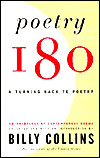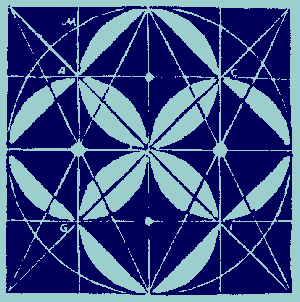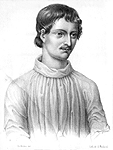salt & pepper shakers becoming friends
Billy Collins, "You Reader"
The first poem read by Collins at his Stanford Reading—
a conversation between himself and his imaginary reader.
the boy's fear of faces in oak furnitures
In his introduction to "Creatures", Billy Collins said:
"I was not afraid of coyotes or bears when I was a child.
I was afraid of furnitures, those knotted faces in pine and oak."
Billy Collins, "Creatures" (
Gettysburg Review, Winter 2001)
also:
Nine Horses, Random House, New York (2002)
counting swans— are they even or odd?
Billy Collins remarked in his introduction to his poem "Genius":
“Yeats wrote
The Wild Swans of Coole [1919] and counted 59 swans and they took off.
Swans are relatively monogamous. So if I counted an even number,
all is well. But if it's an odd number, then I wonder whether
there's a bachelor in the group, or a widow, or widower.”
dancing the Catapult in the 1340's
Billy Collins, "Nostalgia"
from
Picnic, Lightning
University of Pittsburgh Press, Pittsburgh (1998)
his beloved— the bread & the knife
Billy Collins, "Litany"
(Poetry February 2002)
"What He Thought" by Heather McHugh
"What He Thought"
is the first poem in Heather McHugh's Hinge & Sign: Poems 1968-1993,
published by Wesleyan University Press (1994).
It is the last poem in Billy Collins' anthology
Poetry 180: A Turning Back to Poetry,
published by Random House, NY (2003), pp. 269-272.
 This was the only book of Billy Collins' eight books not checked out of the Stanford Library
on Nov. 9, 2003, the day before his Stanford reading. Even though I knew
that Billy Collins was the U.S. Poet Laureate (2001-2003), I had not read
any of his poems before. I checked out Poetry 180 (which Billy Collins
autographed on the title page after his Nov. 10th reading), and read his
introduction to the book and
Poem 1: Billy Collins' "Introduction to Poetry".
Had I read Heather McHugh's poem beforehand, I would have shouted to the
Stanford student who asked whether Billy Collins was a clown—
"Read the last poem in Billy Collins' Poetry 180!" [Note from book:
"This collection is not an exact transcription of the poems on the
Poetry 180 website.
Putting the poems into book form made it possible to include longer poems
as well as poems that came to my attention after the website was put up."]
This was the only book of Billy Collins' eight books not checked out of the Stanford Library
on Nov. 9, 2003, the day before his Stanford reading. Even though I knew
that Billy Collins was the U.S. Poet Laureate (2001-2003), I had not read
any of his poems before. I checked out Poetry 180 (which Billy Collins
autographed on the title page after his Nov. 10th reading), and read his
introduction to the book and
Poem 1: Billy Collins' "Introduction to Poetry".
Had I read Heather McHugh's poem beforehand, I would have shouted to the
Stanford student who asked whether Billy Collins was a clown—
"Read the last poem in Billy Collins' Poetry 180!" [Note from book:
"This collection is not an exact transcription of the poems on the
Poetry 180 website.
Putting the poems into book form made it possible to include longer poems
as well as poems that came to my attention after the website was put up."]
Figura Amoris
 Figura Amoris is one of a series of allegorized geometrical constructions presented
in woodcuts prepared by the Bruno's own hands for Articuli Centum et Sexaginta Adversus
huius Tempestatis Mathematicos atque Philosophos
[Essays upon the Mathematics of Mordente: One Hundred and Sixty Articles
against the Mathematicians and Philosophers of this Age] (Prague: 1588),
a treatise on techniques of geometrical draftsmanship.
Figura Amoris is one of a series of allegorized geometrical constructions presented
in woodcuts prepared by the Bruno's own hands for Articuli Centum et Sexaginta Adversus
huius Tempestatis Mathematicos atque Philosophos
[Essays upon the Mathematics of Mordente: One Hundred and Sixty Articles
against the Mathematicians and Philosophers of this Age] (Prague: 1588),
a treatise on techniques of geometrical draftsmanship.
Notes from J. Vincent Beall:
Figura Amoris is the title of Giordano's hermetic geometric diagram, reproduced here from Frances Yates
Giordano Bruno and the Hermetic Tradition. He also had a simple notation for the diagram that he used
in manuscripts which was a small five pointed star. From this I have assumed that the golden section
is to be conveyed by the diagram. It is the key to drawing correctly proportioned five pointed stars.
The basic module of the diagram is the double square with a unit circle centered on one corner.
Drawing the diagonal through the two squares from the opposite corner of the rectangle completing
the diameter of the unit circle demonstrates in its length, compared to the long edge of the two
square rectangle, the golden section. I think Giordano Bruno must have seen this diagram as coveying
the magical essence of the pentagram through its demonstration of the golden section proportion.
And the pentagram the symbol of love in its ability to reproduce itself, through its central pentagon.
Frances Yates
Frances Amelia Yates (1899-1981)
was born in Southsea (London) on November 28, 1899 and died at home in Claygate (Surbiton)
on Sept. 29, 1981 at the age of 81. Yates received a MA in French theater from London University in 1926.
In 1944, she became a full-time lecturer and editor of publications at the Warburg Institute, London.
She was declared Dame of the British Empire in 1977, and awarded
the Galileo Prize in 1978. Some of my favorite books by Yates are
and
Giordano Bruno and the Hermetic Tradition (1964),
The Art of Memory (1966),
The Rosicrucian Enlightenment (1971),
The Occult Philosophy in the Elizabethan Age (1979).
Yates' knowledge of the Renaissance runs deep because she is always ferreting out the primary sources.
While her scholarship breaks new ground as a professional historian, Yates writes for the common
reader. She is able to synthesize many of the strands of Greek, Medieval and Renaissance philosophies
into an organic whole and relate it to modern science as well. Here's an essay
"On Frances Yates" by Ernest Gombrich
from The New York Review of Books (March 3, 1983)
Giordano Bruno and the Hermetic Tradition
 Giordano Bruno and the Hermetic Tradition is a ground-breaking book by Frances A. Yates.
Originally published by University of Chicago Press in 1964, it documents the philosophers and
practioners of magic and occultism in the Renaissance. The focus is on Giordano Bruno (1548-1600)
and his place in the Hermetic tradition. I recall my first spiritual mentor
Anthony Damiani
always having this book in his hands (1968-1970). I didn't read it until the summer of 1985
when I bought the book at the Stanford Bookstore. At the time I was researching the symbolism
in Albrecht Dürer's Melencolia I (1514). Yates' book elucidated many of the
esoteric arts and philosophies of the Renaissance. It also taught me to appreciate the
philosophical insights of Giordano Bruno and how he was more courageous than Galileo,
considered by many as the father of modern science. See book review by J. Bronowski
"A Dark Side of the Renaissance"
in The New York Review of Books (Sept. 10, 1964).
Giordano Bruno and the Hermetic Tradition is a ground-breaking book by Frances A. Yates.
Originally published by University of Chicago Press in 1964, it documents the philosophers and
practioners of magic and occultism in the Renaissance. The focus is on Giordano Bruno (1548-1600)
and his place in the Hermetic tradition. I recall my first spiritual mentor
Anthony Damiani
always having this book in his hands (1968-1970). I didn't read it until the summer of 1985
when I bought the book at the Stanford Bookstore. At the time I was researching the symbolism
in Albrecht Dürer's Melencolia I (1514). Yates' book elucidated many of the
esoteric arts and philosophies of the Renaissance. It also taught me to appreciate the
philosophical insights of Giordano Bruno and how he was more courageous than Galileo,
considered by many as the father of modern science. See book review by J. Bronowski
"A Dark Side of the Renaissance"
in The New York Review of Books (Sept. 10, 1964).
it's as if the top of my head were taken off...
making my whole body so cold no fire can ever warm me
One of the most powerful definitions of poetry and my favorite may be found in
Emily Dickinson's 1870
remark to Thomas Wentworth Higginson (1823-1911):
“If I read a book and it makes my whole body so cold no fire can ever warm me,
I know that is poetry. If I feel physically as if the top of my head were taken off,
I know that is poetry. These are the only ways I know it. Is there any other way?”
![]()


 Figura Amoris is one of a series of allegorized geometrical constructions presented
in woodcuts prepared by the Bruno's own hands for Articuli Centum et Sexaginta Adversus
huius Tempestatis Mathematicos atque Philosophos
[Essays upon the Mathematics of Mordente: One Hundred and Sixty Articles
against the Mathematicians and Philosophers of this Age] (Prague: 1588),
a treatise on techniques of geometrical draftsmanship.
Figura Amoris is one of a series of allegorized geometrical constructions presented
in woodcuts prepared by the Bruno's own hands for Articuli Centum et Sexaginta Adversus
huius Tempestatis Mathematicos atque Philosophos
[Essays upon the Mathematics of Mordente: One Hundred and Sixty Articles
against the Mathematicians and Philosophers of this Age] (Prague: 1588),
a treatise on techniques of geometrical draftsmanship.